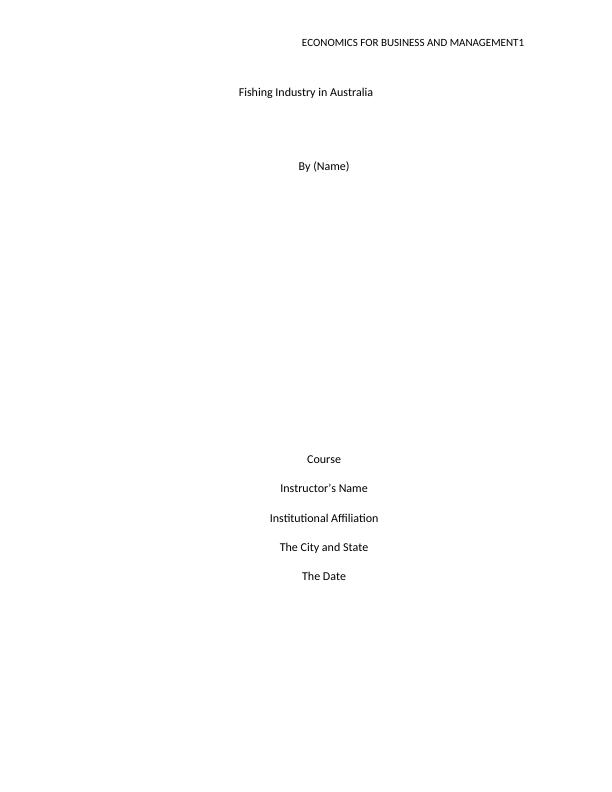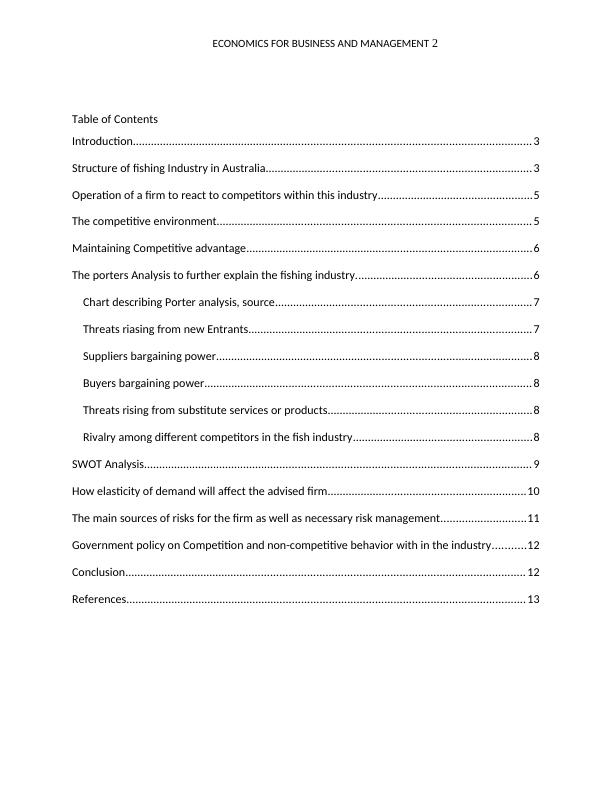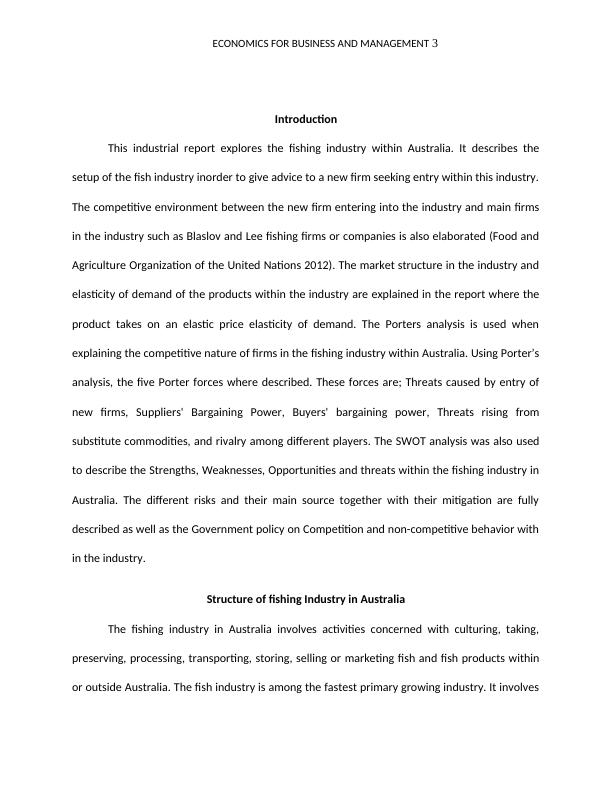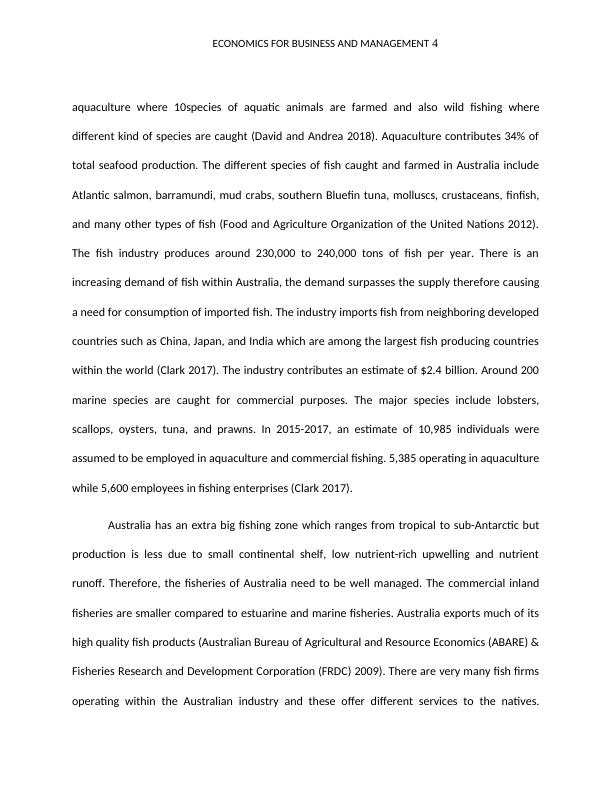Fishing Industry in Australia: Market Structure, Competitive Environment, and Risk Management
Added on 2023-06-04
17 Pages2994 Words334 Views
ECONOMICS FOR BUSINESS AND MANAGEMENT1
Fishing Industry in Australia
By (Name)
Course
Instructor’s Name
Institutional Affiliation
The City and State
The Date
Fishing Industry in Australia
By (Name)
Course
Instructor’s Name
Institutional Affiliation
The City and State
The Date

ECONOMICS FOR BUSINESS AND MANAGEMENT 2
Table of Contents
Introduction................................................................................................................................... 3
Structure of fishing Industry in Australia.......................................................................................3
Operation of a firm to react to competitors within this industry...................................................5
The competitive environment....................................................................................................... 5
Maintaining Competitive advantage..............................................................................................6
The porters Analysis to further explain the fishing industry..........................................................6
Chart describing Porter analysis, source....................................................................................7
Threats riasing from new Entrants.............................................................................................7
Suppliers bargaining power........................................................................................................8
Buyers bargaining power........................................................................................................... 8
Threats rising from substitute services or products...................................................................8
Rivalry among different competitors in the fish industry...........................................................8
SWOT Analysis............................................................................................................................... 9
How elasticity of demand will affect the advised firm.................................................................10
The main sources of risks for the firm as well as necessary risk management............................11
Government policy on Competition and non-competitive behavior with in the industry...........12
Conclusion................................................................................................................................... 12
References................................................................................................................................... 13
Table of Contents
Introduction................................................................................................................................... 3
Structure of fishing Industry in Australia.......................................................................................3
Operation of a firm to react to competitors within this industry...................................................5
The competitive environment....................................................................................................... 5
Maintaining Competitive advantage..............................................................................................6
The porters Analysis to further explain the fishing industry..........................................................6
Chart describing Porter analysis, source....................................................................................7
Threats riasing from new Entrants.............................................................................................7
Suppliers bargaining power........................................................................................................8
Buyers bargaining power........................................................................................................... 8
Threats rising from substitute services or products...................................................................8
Rivalry among different competitors in the fish industry...........................................................8
SWOT Analysis............................................................................................................................... 9
How elasticity of demand will affect the advised firm.................................................................10
The main sources of risks for the firm as well as necessary risk management............................11
Government policy on Competition and non-competitive behavior with in the industry...........12
Conclusion................................................................................................................................... 12
References................................................................................................................................... 13

ECONOMICS FOR BUSINESS AND MANAGEMENT 3
Introduction
This industrial report explores the fishing industry within Australia. It describes the
setup of the fish industry inorder to give advice to a new firm seeking entry within this industry.
The competitive environment between the new firm entering into the industry and main firms
in the industry such as Blaslov and Lee fishing firms or companies is also elaborated (Food and
Agriculture Organization of the United Nations 2012). The market structure in the industry and
elasticity of demand of the products within the industry are explained in the report where the
product takes on an elastic price elasticity of demand. The Porters analysis is used when
explaining the competitive nature of firms in the fishing industry within Australia. Using Porter’s
analysis, the five Porter forces where described. These forces are; Threats caused by entry of
new firms, Suppliers' Bargaining Power, Buyers' bargaining power, Threats rising from
substitute commodities, and rivalry among different players. The SWOT analysis was also used
to describe the Strengths, Weaknesses, Opportunities and threats within the fishing industry in
Australia. The different risks and their main source together with their mitigation are fully
described as well as the Government policy on Competition and non-competitive behavior with
in the industry.
Structure of fishing Industry in Australia
The fishing industry in Australia involves activities concerned with culturing, taking,
preserving, processing, transporting, storing, selling or marketing fish and fish products within
or outside Australia. The fish industry is among the fastest primary growing industry. It involves
Introduction
This industrial report explores the fishing industry within Australia. It describes the
setup of the fish industry inorder to give advice to a new firm seeking entry within this industry.
The competitive environment between the new firm entering into the industry and main firms
in the industry such as Blaslov and Lee fishing firms or companies is also elaborated (Food and
Agriculture Organization of the United Nations 2012). The market structure in the industry and
elasticity of demand of the products within the industry are explained in the report where the
product takes on an elastic price elasticity of demand. The Porters analysis is used when
explaining the competitive nature of firms in the fishing industry within Australia. Using Porter’s
analysis, the five Porter forces where described. These forces are; Threats caused by entry of
new firms, Suppliers' Bargaining Power, Buyers' bargaining power, Threats rising from
substitute commodities, and rivalry among different players. The SWOT analysis was also used
to describe the Strengths, Weaknesses, Opportunities and threats within the fishing industry in
Australia. The different risks and their main source together with their mitigation are fully
described as well as the Government policy on Competition and non-competitive behavior with
in the industry.
Structure of fishing Industry in Australia
The fishing industry in Australia involves activities concerned with culturing, taking,
preserving, processing, transporting, storing, selling or marketing fish and fish products within
or outside Australia. The fish industry is among the fastest primary growing industry. It involves

ECONOMICS FOR BUSINESS AND MANAGEMENT 4
aquaculture where 10species of aquatic animals are farmed and also wild fishing where
different kind of species are caught (David and Andrea 2018). Aquaculture contributes 34% of
total seafood production. The different species of fish caught and farmed in Australia include
Atlantic salmon, barramundi, mud crabs, southern Bluefin tuna, molluscs, crustaceans, finfish,
and many other types of fish (Food and Agriculture Organization of the United Nations 2012).
The fish industry produces around 230,000 to 240,000 tons of fish per year. There is an
increasing demand of fish within Australia, the demand surpasses the supply therefore causing
a need for consumption of imported fish. The industry imports fish from neighboring developed
countries such as China, Japan, and India which are among the largest fish producing countries
within the world (Clark 2017). The industry contributes an estimate of $2.4 billion. Around 200
marine species are caught for commercial purposes. The major species include lobsters,
scallops, oysters, tuna, and prawns. In 2015-2017, an estimate of 10,985 individuals were
assumed to be employed in aquaculture and commercial fishing. 5,385 operating in aquaculture
while 5,600 employees in fishing enterprises (Clark 2017).
Australia has an extra big fishing zone which ranges from tropical to sub-Antarctic but
production is less due to small continental shelf, low nutrient-rich upwelling and nutrient
runoff. Therefore, the fisheries of Australia need to be well managed. The commercial inland
fisheries are smaller compared to estuarine and marine fisheries. Australia exports much of its
high quality fish products (Australian Bureau of Agricultural and Resource Economics (ABARE) &
Fisheries Research and Development Corporation (FRDC) 2009). There are very many fish firms
operating within the Australian industry and these offer different services to the natives.
aquaculture where 10species of aquatic animals are farmed and also wild fishing where
different kind of species are caught (David and Andrea 2018). Aquaculture contributes 34% of
total seafood production. The different species of fish caught and farmed in Australia include
Atlantic salmon, barramundi, mud crabs, southern Bluefin tuna, molluscs, crustaceans, finfish,
and many other types of fish (Food and Agriculture Organization of the United Nations 2012).
The fish industry produces around 230,000 to 240,000 tons of fish per year. There is an
increasing demand of fish within Australia, the demand surpasses the supply therefore causing
a need for consumption of imported fish. The industry imports fish from neighboring developed
countries such as China, Japan, and India which are among the largest fish producing countries
within the world (Clark 2017). The industry contributes an estimate of $2.4 billion. Around 200
marine species are caught for commercial purposes. The major species include lobsters,
scallops, oysters, tuna, and prawns. In 2015-2017, an estimate of 10,985 individuals were
assumed to be employed in aquaculture and commercial fishing. 5,385 operating in aquaculture
while 5,600 employees in fishing enterprises (Clark 2017).
Australia has an extra big fishing zone which ranges from tropical to sub-Antarctic but
production is less due to small continental shelf, low nutrient-rich upwelling and nutrient
runoff. Therefore, the fisheries of Australia need to be well managed. The commercial inland
fisheries are smaller compared to estuarine and marine fisheries. Australia exports much of its
high quality fish products (Australian Bureau of Agricultural and Resource Economics (ABARE) &
Fisheries Research and Development Corporation (FRDC) 2009). There are very many fish firms
operating within the Australian industry and these offer different services to the natives.

End of preview
Want to access all the pages? Upload your documents or become a member.
Related Documents
Porter's Five Forces Model for Business Strategy (P3)lg...
|12
|561
|228
Five Forces Analysis of Kitkatlg...
|7
|1324
|1203
Assignment on Australian Meat Industry - NUT201lg...
|12
|1965
|215
Supply Chain Strategy Framework Reportlg...
|12
|2312
|12
Strategy and Changelg...
|12
|2438
|404
Strategic Management.lg...
|7
|1606
|93
